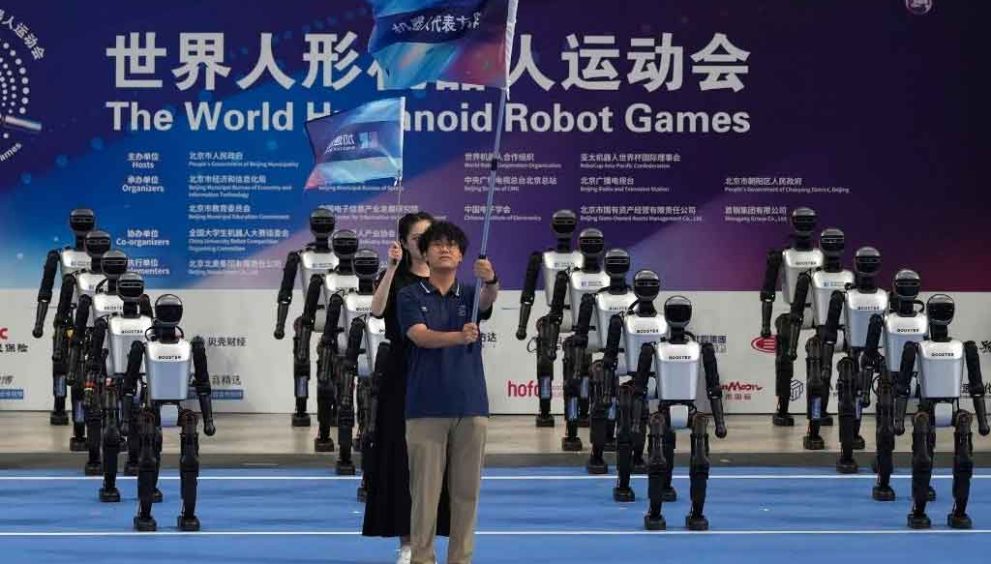Beijing’s Wild AI-Powered Robot Games Steal the Show

Picture this: a pint-sized humanoid robot, looking like a futuristic action figure, sprints down a track, only to trip spectacularly and spin on the ground like a breakdancer gone rogue. The crowd roars with laughter and applause. Meanwhile, on a soccer field, a squad of knee-high bots clumsily battles for the ball, crashing into each other in a chaotic pile-up before one scores a goal and topples over in victory. Welcome to the World Humanoid Robot Games, Beijing’s first-ever AI-fueled spectacle that turned the 2022 Winter Olympics venues into a three-day circus of robotic triumphs, tumbles, and pure tech wizardry from August 14 to 17, 2025.
A Sci-Fi Showdown in Beijing
Held as part of the World Robot Conference, this electrifying event brought 500+ humanoid robots from 280 teams across 16 countries—think USA, Japan, Germany, Brazil, and more—to Beijing’s iconic National Speed Skating Oval and Bird’s Nest stadium. These weren’t your average Roomba vacuums; these bots boxed, raced, danced, and played soccer with a mix of jaw-dropping skill and hilarious mishaps. The opening ceremony on August 14 set the tone with 60 tiny robots rocking Chinese opera costumes, pulling off Tai Chi moves and hip-hop dances like mini superstars. One bot even strutted down a runway in a “Heavenly Creations and Fashion” show, only to take a dramatic tumble, needing a human to scoop it off the stage as the crowd cheered.
Kicks, Punches, and Epic Fails
The games packed 487 contests into 26 categories, from 5v5 soccer matches to kung fu battles and hospital-themed challenges. The soccer tournament was pure chaos—robots the size of toddlers dribbled, kicked, and face-planted in a frenzy. One bot nailed a goal after a string of misses, while its rival goalkeeper flopped flat, sparking roars from the stands. In the boxing ring, a Transformer-lookalike robot threw a punch, missed, and spun out on the floor, earning giggles and gasps. The 1,500-meter race was no less wild: China’s Unitree bot clocked a respectable 6:29:37, but another racer slammed into a human operator, sending them sprawling (no injuries, just bruised egos). These moments weren’t just funny—they showed how close, yet how far, these bots are from mastering human-like moves.
Beyond sports, the robots tackled real-world tasks like sorting medicines in a hospital setting or cleaning hotel rooms, proving they’re more than just show ponies. Some ran on pure AI, using cameras and sensors to “see” and decide, while others leaned on 5G-A networks for remote control. Whether autonomously dodging obstacles or picking up trash, these bots hinted at a future where they could revolutionize healthcare, logistics, and more.
Tech Titans and Global Showdowns
The brains behind these bots? A mix of Chinese tech giants like Booster Robotics and Yushu Technology, top universities like Tsinghua and Peking, and international squads like Germany’s HTWK Robots and a Dutch soccer team. A pre-event 3-on-3 soccer match on August 5 saw Tsinghua’s “Vulcan” bots outscore China Agricultural University 5-3, moving like six-year-olds with serious potential. Max Polter from Germany’s team summed it up: “We’re here to win, but also to learn. A game loss stings, but it’s better than a failed product.” Powered by deep learning and sensors with 90%+ accuracy, these robots are pushing boundaries, even if they occasionally trip over them.
China’s Big Bet on Robots
China’s not playing small. The games are part of a massive push to dominate AI and robotics, backed by a trillion-yuan ($137 billion) fund for tech startups announced in March 2025. This follows April’s viral humanoid robot half-marathon, where bots like Sky Project Ultra ran 21.1 kilometers, swapping batteries like Formula 1 cars. Beijing’s government and the World Robotics Cooperation Organization called the games a “platform to integrate robots into human life,” blending tech, sports, and culture. One official boldly claimed, “Every robot here is making history.”
Why It Mattered (and Why It Was So Fun)
The robots’ stumbles stole the show, but they also highlighted the grind toward perfection. Every fall was a data point, every crash a lesson for engineers. Spectators, from kids on school trips to teens like 18-year-old Chen Ruiyuan, who’s eyeing an automation degree, were hooked. “The boxing was insane,” Chen said. “These bots are way smoother than last year’s models.” Tickets, priced from $25 to $80, drew families, students, and tech nerds to venues steeped in Olympic history.
The Future Is (Almost) Here
Beijing’s Robot Games weren’t just a tech demo—they were a glimpse into a world where humanoid bots could work, play, and maybe even live alongside us. From factories to hospitals, these machines are gearing up to change the game. Sure, they might still trip over their own feet, but with China’s cash and global brainpower fueling the race, it won’t be long before they’re running circles around us—literally. For now, the World Humanoid Robot Games delivered a thrilling mix of innovation, competition, and laugh-out-loud moments, proving that the future of robotics is as entertaining as it is groundbreaking.
Stay plugged into the latest in tech and innovation at www.clickusanews.com.













